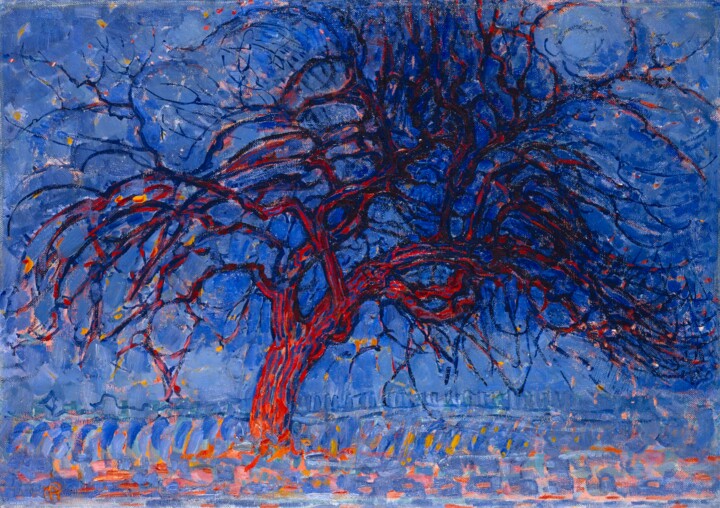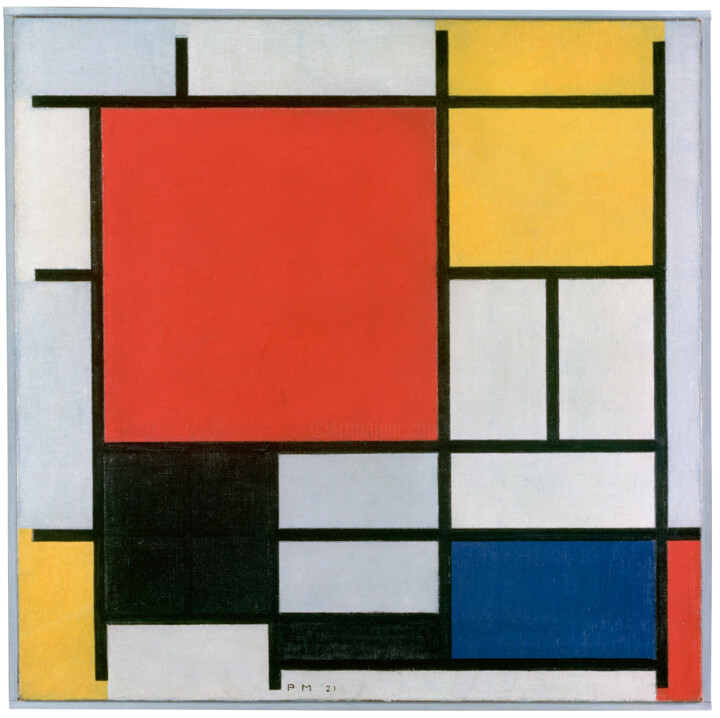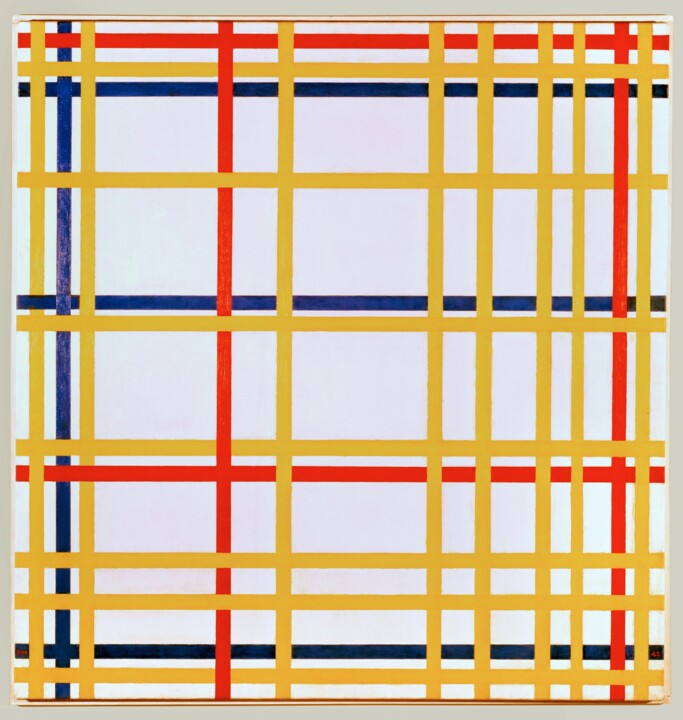 A portrait of Piet Mondrian by an unknown author, 1899. The Kunstmuseum Den Haag
A portrait of Piet Mondrian by an unknown author, 1899. The Kunstmuseum Den Haag
Who was Piet Mondrian?
Piet Mondrian was a Dutch painter who was born in 1872 and died in 1944. He is known for his contributions to the development of abstract art, particularly his use of geometric shapes and primary colors. Mondrian's paintings are characterized by a grid of horizontal and vertical lines, with squares and rectangles filled in with blocks of color. His style, known as neoplasticism, aimed to create a sense of harmony and order through the use of simple forms and colors.
Mondrian was also closely associated with the De Stijl movement, a Dutch artistic and design movement founded in 1917 by a group of artists and designers. De Stijl, which means "The Style" in Dutch, was founded on the principles of simplicity, harmony, and order. Its members believed that art should be stripped down to its essential elements - simple geometric forms and primary colors - and that it should be integrated into everyday life.
 Piet Mondrian - Composition with Red Blue and Yellow, 1930. Oil on canvas. Kunsthaus Zürich, Switzerland
Piet Mondrian - Composition with Red Blue and Yellow, 1930. Oil on canvas. Kunsthaus Zürich, Switzerland
Mondrian played a central role in the development of the De Stijl movement, and his art became the embodiment of its principles. His signature style, characterized by a grid of vertical and horizontal lines and blocks of primary colors, became the hallmark of the movement.
Mondrian's work had a significant influence on the development of modern art, particularly in the fields of abstract art and minimalism.
Life and work of Piet Mondrian
Piet Mondrian was born in Amersfoort, the Netherlands, in 1872. His father was a schoolteacher, and his mother was a pianist. Mondrian showed an early interest in art and began taking drawing lessons when he was around 10 years old.
After completing his formal education, Mondrian enrolled in the Academy of Fine Arts in Amsterdam in 1892. However, he soon became disillusioned with the academic style of art that was being taught there, and he began to explore new artistic styles on his own.
 Piet Mondrian - Willow Grove: Impression of Light and Shadow, 1905. Oil on canvas. Dallas Museum of Art, Dallas, Texas, USA
Piet Mondrian - Willow Grove: Impression of Light and Shadow, 1905. Oil on canvas. Dallas Museum of Art, Dallas, Texas, USA
Piet Mondrian's early works were largely influenced by the landscape paintings of the Dutch Impressionists, and he initially worked in a traditional representational style. However, in the early years of the 20th century, he began to experiment with more abstract forms and to incorporate elements of Cubism and Futurism into his work. He was introduced to the works of the Cubists, such as Georges Braque and Pablo Picasso, and was profoundly influenced by their use of straightforward geometric forms and rejection of conventional representational art.
Mondrian's early paintings from this period are characterized by their bold colors, strong lines, and simplified forms. He began to move away from representational subjects and towards a more abstract, in which the emphasis was on the formal qualities of the painting rather than on the depiction of a recognizable subject.
Mondrian's early works were an important stepping stone in his development as an artist, laying the foundation for his later explorations of the principles of abstract art. They represent a period of experimentation and discovery, in which he began to push the boundaries of traditional painting and to explore new possibilities for artistic expression.
 Piet Mondrian - Evening; Red Tree, 1908–1910. Oil on canvas, 70 × 99 cm, Kunstmuseum Den Haag, The Hague
Piet Mondrian - Evening; Red Tree, 1908–1910. Oil on canvas, 70 × 99 cm, Kunstmuseum Den Haag, The Hague
One of Mondrian's most important early works is "Evening; Red Tree" (1908–1910). This painting is still representational, but it shows the influence of the Fauvist movement in its bold use of color and its emphasis on expressive brushwork.
In 1911, Mondrian moved to Paris and became involved with a group of artists known as De Stijl. This group aimed to create a new form of art that was based on simple geometric forms and primary colors. Mondrian's work from this period was marked by a shift towards abstraction, with his paintings featuring grids of vertical and horizontal lines, and blocks of primary colors.
Another significant early work is "The Gray Tree," painted in 1911. This painting shows the influence of Cubism in its fragmented, geometric forms, and it marks the beginning of Mondrian's transition to a fully abstract style.
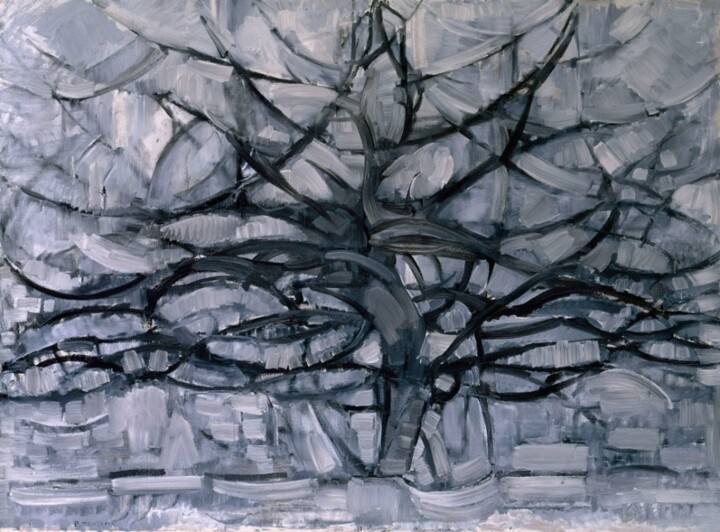 Piet Mondrian - Gray Tree, 1911. Oil on canvas. Kunstmuseum Den Haag, The Hague
Piet Mondrian - Gray Tree, 1911. Oil on canvas. Kunstmuseum Den Haag, The Hague
Over the next few years, Mondrian's work began to evolve, as he experimented with increasingly abstract forms. His work was characterized by the use of a grid of horizontal and vertical lines, and the reduction of forms to their most basic geometric shapes.
By the 1920s, Mondrian had become a leading figure in the development of the De Stijl movement in the Netherlands, which sought to create a new form of art that was universal, objective, and timeless. Mondrian's work during this period was marked by his use of simple forms and primary colors, which aimed to create a sense of harmony and order.
Mondrian's early work also includes his series of "lozenge" paintings, created between 1918 and 1921. These paintings feature diamond-shaped forms in various configurations, demonstrating Mondrian's interest in the interplay between positive and negative space.
Mature period
Piet Mondrian's mature period is characterized by his development of the De Stijl movement and his iconic use of primary colors and simple geometric forms. Mondrian's work during this period, which lasted from the 1920s to his death in 1944, is considered some of the most important and influential art of the 20th century.
In 1938, as the threat of war in Europe was growing, Mondrian left Paris and moved to London, where he lived for two years before emigrating to New York City in 1940. In New York, Mondrian became associated with a group of artists known as the Abstract Expressionists, who were working in a similar vein to his own. He continued to work on his abstract paintings, which had a significant impact on the development of American abstract art.
Mondrian believed that his art should be a reflection of the universal principles of harmony and order that he saw in the world, and he sought to express these principles through his use of simple forms and pure colors. He believed that by reducing forms to their most basic elements, he could create a sense of clarity and balance that would be universally understood.
 Piet Mondrian - Composition No. 10, 1939–1942. Oil on canvas. Private collection.
Piet Mondrian - Composition No. 10, 1939–1942. Oil on canvas. Private collection.
One of Mondrian's most famous works from this period is his series of paintings known as the "Composition" paintings, which feature a grid of black lines filled with blocks of primary colors. These works have become iconic examples of modernist art, and their influence can be seen in everything from graphic design to fashion.
Mondrian's mature period was marked by his continued experimentation. In addition to his paintings, Mondrian also created a series of sculptures and architectural models that reflected his interest in the integration of art and design. He was constantly pushing the boundaries of what was possible in art, and his work had a profound influence on the development of modern art in the 20th century.
Wall works
Piet Mondrian began creating wall works in the late 1920s, during his mature period. These works were an extension of his exploration of the principles of abstract art and his belief that art should be integrated into everyday life. These works were large-scale, site-specific installations that were designed to transform the architectural space they occupied, creating a sense of harmony and order.
Mondrian's wall works were typically composed of a grid of vertical and horizontal lines, which were filled in with blocks of primary colors. The colors were carefully chosen and arranged to create a sense of balance and rhythm, with each element of the composition contributing to the overall effect.
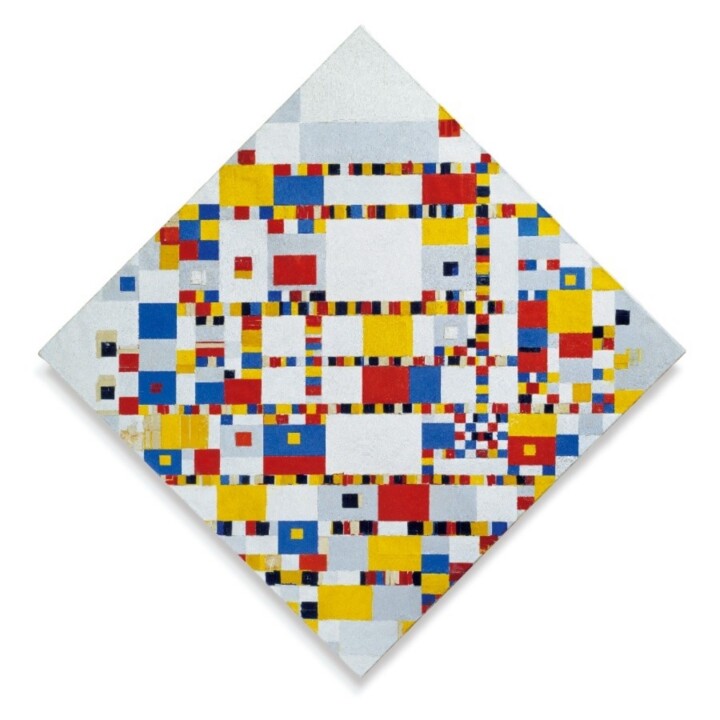 Piet Mondrian - Victory Boogie Woogie, 1942–1944. Kunstmuseum Den Haag, The Hague
Piet Mondrian - Victory Boogie Woogie, 1942–1944. Kunstmuseum Den Haag, The Hague
One of Mondrian's most famous wall works is the “Victory Boogie Woogie” (1944), which he was working on at the time of his death. This work, which was intended to be a monumental mural for the city of Amsterdam, consists of a grid of colored squares that are arranged in a dynamic pattern that suggests movement and rhythm.
Mondrian's wall works were an important part of his legacy, and they represent a bold and innovative approach to art and design, in which the boundaries between art and everyday life are blurred, and the principles of harmony and order are applied to all aspects of human experience.
Death and legacy of Piet Mondrian
Despite his age and declining health, Mondrian continued to work tirelessly during his late years, producing a large body of work. He lived a spartan lifestyle, devoting himself entirely to his art and his spiritual pursuits. Piet Mondrian's late years were marked by his continued exploration of the principles of abstract art, as well as his growing interest in theosophy, a spiritual movement that sought to unify the world's religions and philosophies. He died in New York City in 1944 at the age of 71.
Mondrian's pioneering work in the development of abstract art, and his exploration of the principles of harmony and order, have had a profound impact on subsequent generations of artists, and has become iconic and instantly recognizable.
Mondrian's use of simple forms and primary colors aimed to create a sense of harmony and order, and his work has had a profound impact on the development of modern art. His emphasis on abstraction and the reduction of form to its most basic elements paved the way for the emergence of minimalism in the 1960s.
Mondrian was also a key figure in the development of the De Stijl movement in the Netherlands, which aimed to create a new form of art that was universal, objective, and timeless.
His influence can be seen not only in the world of art, but also in fashion, design, and architecture, where his use of grids and primary colors has inspired countless designers and architects to create clean, modernist designs. His legacy is a testament to his groundbreaking vision, and to his unwavering commitment to the principles of abstraction and harmony.
Important art by Piet Mondrian
Piet Mondrian created many important works of art throughout his career, but there are several that are particularly significant:
"Composition with Red, Blue and Yellow” (1930) - This painting is one of Mondrian's most famous works and is a prime example of his use of grids and primary colors. It features a series of rectangles and squares in red, yellow, and blue, arranged on a grid of black lines.
"Victory Boogie Woogie" (1942-44) - This unfinished painting is one of Mondrian's last works and is considered a masterpiece of abstract art. It features a complex grid of colorful rectangles and squares, with the colors arranged in a seemingly random pattern.
"Tableau No. 2/Composition No. VII" (1913) - This early work by Mondrian shows the influence of Cubism and features a grid of intersecting lines and planes. The colors are muted and subdued, in contrast to Mondrian's later use of primary colors.
 Piet Mondrian - Broadway Boogie Woogie, 1942-43. Oil on canvas. 127 × 127 cm. Museum of Modern Art, New York
Piet Mondrian - Broadway Boogie Woogie, 1942-43. Oil on canvas. 127 × 127 cm. Museum of Modern Art, New York
"Broadway Boogie Woogie" (1942-43) - This painting was inspired by the bustling streets of New York City and features a grid of colorful squares and rectangles, arranged in a dynamic, pulsating pattern.
"Composition No. 10" (1939–1942) - Mondrian believed that art should reflect the universal principles of harmony, balance, and order, and his artwork aimed to reduce the visual elements to their essential forms. "Composition No. 10" is a prime example of Mondrian's exploration of these principles, as he sought to create a visual language that expressed the spiritual and emotional qualities of the world around him.
"New York City" (1942) - This artwork is an abstract representation of the cityscape of New York, which Mondrian had recently moved to. Mondrian was inspired by the architecture and energy of New York City, and his artwork reflects the city's urban landscape and modernist spirit.
 Piet Mondrian - New York City, 1942. Oil on canvas. 119.3 x 114.2 cm. Musée National d'Art Moderne, Paris
Piet Mondrian - New York City, 1942. Oil on canvas. 119.3 x 114.2 cm. Musée National d'Art Moderne, Paris
Mondrian's influence on popular culture
Piet Mondrian's influence on popular culture is significant and far-reaching. His use of grids, primary colors, and simple geometric shapes has inspired countless designers, artists, and architects, and his legacy can be seen in everything from fashion to advertising.
In the world of fashion, Mondrian's influence can be seen in the work of designers such as Yves Saint Laurent, who famously created a collection of dresses inspired by Mondrian's paintings in the 1960s. The bold, geometric designs of these dresses have since become iconic, and continue to be referenced by designers today.
Mondrian's influence can also be seen in the world of design, particularly in the areas of graphic design and product design. His use of simple geometric forms and bold colors has been widely imitated, and often used in advertising and branding. For example, the logos for several major companies, including Pepsi and Crate & Barrel, have been inspired by Mondrian's work.
Mondrian's influence has also been felt in the world of architecture, particularly in the area of modernist architecture. His emphasis on order and simplicity, and his belief that art and architecture should be integrated, have had a profound impact on architects and designers. The principles of Mondrian's style can be seen in the work of architects such as Le Corbusier and Mies van der Rohe, who were inspired by Mondrian's vision of a harmonious and ordered world.
Mondrian's impact in various fields can be attributed to his groundbreaking contribution in the development of abstract art, as well as his conviction that art should be seamlessly incorporated into ordinary life.


 Selena Mattei
Selena Mattei

